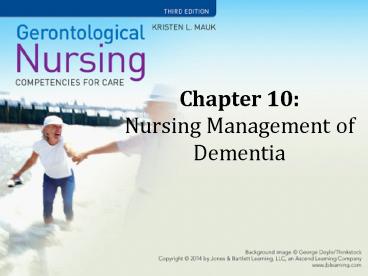Chapter 10: Nursing Management of Dementia - PowerPoint PPT Presentation
1 / 15
Title:
Chapter 10: Nursing Management of Dementia
Description:
Chapter 10: Nursing Management of Dementia Learning Objectives Differentiate among dementia, depression, and delirium. Identify the stages and clinical features of ... – PowerPoint PPT presentation
Number of Views:284
Avg rating:3.0/5.0
Title: Chapter 10: Nursing Management of Dementia
1
Chapter 10 Nursing Management of Dementia
2
Learning Objectives
- Differentiate among dementia, depression, and
delirium. - Identify the stages and clinical features of
dementia. - Describe procedures for diagnosing dementia.
- Recognize and address the common causes of
delirium. - Discuss the theoretical foundations of nursing
care for persons with dementia. - Contrast pharmacological and nonpharmacological
interventions for dementia, delirium, and
depression.
3
Learning Objectives (contd)
- Apply basic principles to provide safe and
effective care for persons with dementia. - List specific nursing interventions for
behavioral and psychological symptoms of
dementia. - Recognize the role of adult day services in the
care of persons with dementia. - Identify the role that palliative care/hospice
care plays for individuals with dementia and
their families.
4
Dementia
- Progressive, degenerative brain dysfunction,
including deterioration in memory, concentration,
language skills, visuospatial skills, and
reasoning, that interferes with a persons daily
functioning - Not considered a normal part of aging
5
Dementia (contd)
- Most common types of dementia in older adults
- Alzheimers disease (most common)
- Vascular dementia (second most common)
- Mixed Alzheimers/vascular dementia
- Parkinsons dementia
- Lewy body dementia (LBD)
- Frontotemporal lobe dementia
6
Dementia (contd)
- Risk factors for dementia
- Age
- Family history
- Genetic factors
- apolipoprotein E-e4 (APOE-e4)
- History of head trauma
- Vascular disease
- Certain types of infections
7
Dementia (contd)
- Alzheimers Disease
- Medical diagnosis (Box 10-5, P. 382 Box 10-8, p.
385) - Stages (mild, moderate, severe) (Box 10-9, p.
386) - Pharmacological intervention
- cholinesterase inhibitors (CEIs) Aricept
- N-methyl-D-aspartate (NMDA) receptor antagonists
Namenda - Medications that cause or worsen confustion
- Anticholinergic (Box 10-6)
- Medications with central nervous system effects
8
Delirium
- Acute confusion (dementia-chronic confusion)
- Develops over hours or days
- Hyperalert (agitated) or hypoactive states
(lethargic) - Confusion Assessment Method (CAM) is developed
based on 4 features of delirium - Acute onset or fluctuating course
- Inattention
- Disorganized thinking
- Altered level of consciousness
- Common Causes of Delirium (Box 10-12, p. 391)
9
Sundowner Syndrome
- A form of delirium and refers to behavior
problems that are sometimes seen in the late
afternoon or early evening when the sun sets. - Nocturnal confusion
- Confusion as the sun goes down
- Increased with unfamiliar surrounding
- Often disturbed sleep patterns
- May result from excess sensory stimulation or
deprivation
10
Depression
- Risk increases in older adults with chronic
illnesses or dementia (box 10-13) - Symptoms
- can be incorrectly attributed to normal aging
- may overlap with dementia
- often include anxiety, agitation, and insomnia
- Potentially life-threatening
- Treatable
- Often under recognizing, undertreated
11
Caring for the Person with Dementia
- Behavioral and Psychological Symptoms (Box 10-15)
- Pharmacological Treatment (Box 10-16)
- Nonpharmacological Treatment for Dementia (Box
10-17, 18) - Pain Management and Alzheimers Disease (Box
10-19, 20, 21) - Activity Interventions
- Communication Interventions (Box 10-22)
- Interventions for Particular Behaviors (p.
405-407) - Activities of Daily Living
12
Settings for CareFocus on Adult Day Services
- Recreational therapy/activities
- Meals
- Social services
- Transportation
- Personal care bathing, hair and nail care
- Nursing services
- Rehabilitation services (less commonly offered)
- Medical services (less commonly offered)
13
Hospice/Palliative Care
- Palliative care
- comprehensive approach to improving the quality
of life for people who are living with
potentially fatal diseases. (Box 10-32) - Advance directives
14
Legislative Action
- National Alzheimers Project Act (2011) calls for
the expansion and coordination of research and
health service delivery across federal agencies
for Alzheimers disease and related dementias. - The top priorities of the Act are to place
significant focus on the dementia people to
improve patient outcomes and to reduce
disparities.
15
Summary
- As population ages, cases of dementia will grow
- Reliable assessment tools are available
- Interventions for the common behaviors
encountered among persons with dementia can help
those persons and their caregivers































